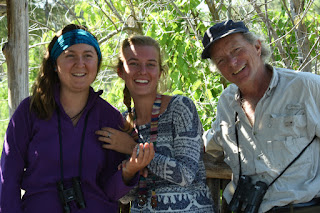We were fortunate enough to be able to take a 5 day guided safari trip. We left our truck behind and climbed aboard a safari vehicle. Just the 4 of us, our guide/driver and our chef. They took us to the most amazing places including a mokoro boat trip. A mokoro is a kind of small canoe commonly used in the Okavango Delta. It is propelled through shallow water by a person standing in the stern and pushing with a pole. We took the mokoros to an island where we spent the night in small tents, listening to the hippos and other wildlife.
The next day our safari vehicle picked us up again and we traveled into the Okavango Delta. The trip in to the national park was long but amazing. We got stuck only once and our guide and chef knew how to get us out. Jack up the vehicle, put brush under the tires, drop the chuck wagon and go for it. Then drag the chuck wagon back to the vehicle, hook up and off you go.
We camped for another 4 nights in the Delta. We had lovely big tents with cots and blankets. Nights were filled with the sounds of lions, hippos and elephants calling. We had small lanterns light around our camp and before getting up in the night you had to listen to hear if there were any animals in camp. Then go out to pee but never alone. We quickly gave up having a beer after dinner and instead sipped whisky so as to avoid too many night time adventures.
Mornings we were up before daylight when Brighton, our chef, or Robbie, our guide, would wake us with a quiet good morning and warm water in camp sinks outside our tents. After a quick cup of coffee and a biscuit we would be off looking for wildlife. We would spend the next 4 hours out and about in our safari truck then come back to camp where Brighton would have a lovely lunch waiting for us. Afternoon naps, camp showers (with warm water), journal writing and photo sorting until 3:00 and then out for another 3 hour game drive. In the Okavango everyone is required to be back in their camps by dark. We pushed that a few times when we would encounter some amazing new wildlife scene and wanted to stay and watch it. It is hard to leave a lion rolling in the dirt, an elephant softly flapping its ears next to your vehicle or a hyena stopping to look back at you. We always got back to camp as darkness arrived. Brighton would have the table set with a tablecloth and some great meal prepared for us. We did not camp in any campgrounds but were assigned places to camp. We had no other people around. The space belonged to us.
Our "budget, participation" safari could not have been any better. We loved Brighton and Robbie, we loved our camp equipment and camp sites, we loved gathering around the fire each night and reliving our adventures and we loved the Okavango.
Next post - Adventuring on our Own


























